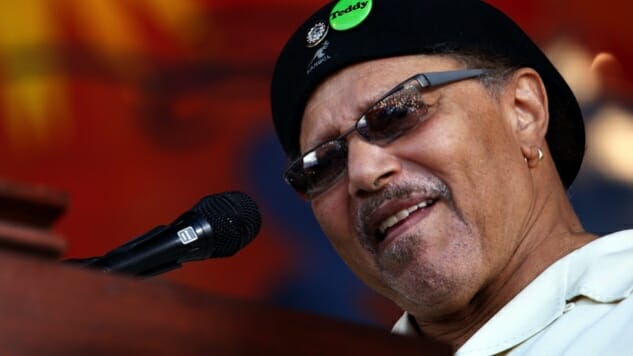The Neville Brothers Lose Their Leader, Art Neville (1937-2019)
Photo by Chris Graythen/Getty
All four of the Neville Brothers were talented, but only two were geniuses: Aaron, the musclebound ex-con with the incongruously angelic high tenor, and Art, the keyboard master of push-and-pull syncopation. Art was the band’s leader, and now he’s gone. He died Monday at his home in New Orleans after years of declining health at age 81. He was the oldest of the quartet; Charles the saxophonist, a year younger, died last year; Cyril, singer and percussionist, and Aaron live on.
“Art is the honcho,” Aaron told me in 1985. “He works out the arrangements and keeps us tight. We’ve come through a lot of stuff with each other, but we’re men now. We all live in the same two blocks and see each other every day. We play together as a family, and that keeps us young. It’s a good feeling to look at one of my brothers on stage and see all my ancestors in his face.”
“I’m the big brother,” Art told me in 1994. “I didn’t ask to be; I just am. You have to agree you’re going to disagree sometimes, but you can’t let ego and foolish pride break up a family, and I don’t intend for that to ever happen.”
Art was the leader of every band he was in; he had that kind of personality and the musical chops to back it up. Whether playing Professor Longhair’s second-line rhythms on the piano or New Orleans church swells and Jimmy Smith jazz riffs on the organ, Art had a way of putting his own stamp on the sound and establishing that sound as the basis for everything else that happened on stage. Cyril talked a lot more at shows, but it was obvious that Art was directing traffic.
Even at age 17, he took charge of a teenage band called the Hawketts and sang lead on their one claim to fame, a 1954 single called “Mardi Gras Mambo,” a tune so infectious that you still hear it all over New Orleans 65 carnival seasons later. After recording some solo singles, he formed Art Neville & the Neville Sounds, a band that included Aaron, Cyril, bassist George Porter Jr., guitarist Leo Nocentelli, drummer Joseph “Zigaboo” Modeliste and saxophonist Gary Brown. Their weekly mid-’60s shows in the French Quarter were legendary.
“I was playing on Bourbon Street at the Bayou Room,” Jimmy Buffett told me in 1989, “and Art and Aaron were down the street at the Ivanhoe. So we go back a long way. But once you get attached to the Neville Brothers music, you never let go of it.”
Producer and songwriter Allen Toussaint was so impressed that he hired Art, George, Leo and Zigaboo as the house band at Sea Saint Studio, where they played on Toussaint’s productions of LaBelle, Robert Palmer, Lee Dorsey, Dr. John and many more. Toussaint had them record their own music as the Meters, an instrumental quartet so funky that people are still sampling their records today. They were the Louisiana equivalent of Booker T. & the MGs, and like Booker T. Jones, Art led the band from the organ bench. Little Feat based their original concept on the Meters.
Cyril joined the Meters in its later phase, and Aaron and Charles joined that line-up for a special 1976 project led by the Neville brothers’ uncle George “Jolly” Landry, the big chief of the Wild Tchoupitoulas, a Mardi Gras Indian tribe. This old New Orleans tradition has African-Americans creating elaborately beaded and feathered Indian costumes and parading through the cities streets on Mardi Gras Day and St. Joseph’s Day to see which tribe could intimidate all the others.
As they paraded, they would bang and rattle percussion instruments and sing call-and-response chants such as “Iko Iko,” “Brother John” and “Hey Pocky Way.” Art had the idea of giving those chants vocal harmonies from the Neville Brothers and instrumental backing from the Meters. The result was one of the greatest New Orleans albums of all time, Wild Tchoupitoulas, and its critical triumph convinced the Neville Brothers to commit themselves to the family band.
They released two underappreciated studio albums in 1978 and 1981, but their live gigs quickly became the must-see show in New Orleans. When they released the thrilling album, 1984’s Nevillization: Live at Tipitina’s, on the small Louisiana label Black Top, the rest of the world got the message.
“I like to play the funky stuff,” Art told me. “Charles is the avant-garde jazzman. Aaron sings the pretty songs, because he has the voice. Cyril is the fire. That variety is what makes us different. If we didn’t have that, we’d sound like every other band on the radio.”